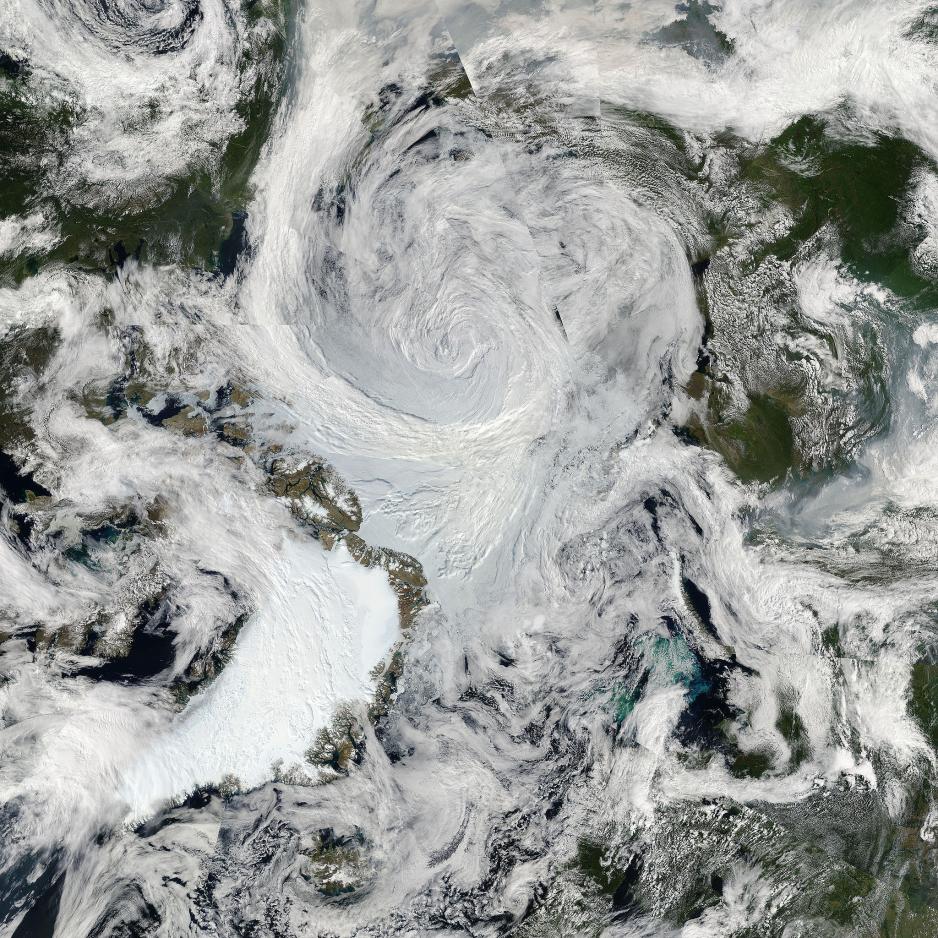Warming Arctic – Extreme Effects

Due to continued warming, more extreme events like this storm could develop over the Arctic in the future. (Photo Credit: NASA Goddard Space Flight Center from Greenbelt, MD, USA (Summer Storm Spins Over Arctic) [CC BY 2.0 (http://creativecommons.org/licenses/by/2.0)], via Wikimedia Commons)
"Arctic warming will have tremendous effects also beyond northern regions. Improving our capacity to forecast extreme events deriving from a warmer Arctic will help us to prepare for the changes ahead", says Dr Steffen M. Olsen, Senior Consultant at the Danish Meteorological Institute in Copenhagen.
"Arctic warming will have tremendous effects also beyond northern regions. Improving our capacity to forecast extreme events deriving from a warmer Arctic will help us to prepare for the changes ahead", says Dr Steffen M. Olsen, Senior Consultant at the Danish Meteorological Institute in Copenhagen.
A large consortium of international partners kick-starts the "Blue-Action" project this week in Berlin, Germany, which aims to help society to better understand and prepare for the effects of a changing Arctic climate.
"We still lack sufficient knowledge about the causes and effects of Arctic warming", says Dr Olsen, who is the coordinator of the project. Thus, Blue-Action will mobilize concentrated efforts to help society cope with the impacts of dramatic Arctic climate changes. The project is a four-year research and innovations project funded by the European Union’s Horizon 2020 programme worth €7.5 million.
Understanding a Warming Arctic
Seven months last year produced new record low sea ice extents. As the overall trend of Arctic sea ice extent continues downwards, environmental changes will become apparent both in the Arctic and in other regions. How these changes affect the regions at lower latitudes and how society can prepare for these effects, however, remains largely unstudied.
The "Blue-Action - Arctic Impact on Weather and Climate" project aims to improve our detailed understanding of the processes and impacts of this changing climate and to construct better long-term forecast systems for the increasingly extreme weather of the Arctic and the wider northern hemisphere", the official press release explains.
More specifically, the project aims to improve capacities to predict the weather in the Arctic and over the northern hemisphere at large on seasonal to decadal time scales. "This information will allow communities and businesses in Eurasia and North America to develop and plan their activities better", the press release elaborates.
Joining multi-disciplinary forces
More than 100 experts from 40 organisations based in 17 different countries will join forces to tackle the ambitious research programme. "Of special importance is the co-creation of the research work between scientists from various disciplines as well as from local authorities and industry, since the research work is meant to make a real difference on the ground", says Dr. Olsen to High North News.
"The research will thus include various activities, ranging from observations to model assessments and modeling experiments to improve prediction systems for the changing Arctic and its effects", adds Dr. Daniela Matei from the Max-Planck Institute for Meteorology in Hamburg, co-coordinator of the Blue-Action project.
Climate services
In order to ensure the project’s results can be used by society, one of Blue-Action’s Work Packages focusses on developing climate services for end-users in different Arctic regions.
"Our goal is to translate the climate data generated in Blue-Action into customized products such as forecasts, trends and economic analysis to be used by society at large", explains Dr Mark Payne, Senior Researcher at the Technical University of Denmark and co-leader of the Climate Services Work Package.
The climate services to be developed in Blue-Action include thermal stress forecasts to reduce temperature related mortality in Europe; seasonal weather forecasts for winter conditions to support the winter tourism industry in Finland; better prediction of cold air outbreaks and extreme winter storms (so-called polar lows) to support Arctic shipping industries; forecasts for the distribution, productivity and timing of commercially important fish stocks; and scenarios for economic developments in the Russian Arctic.
More information about the project and its progress can be found on the Blue-Action homepage.
